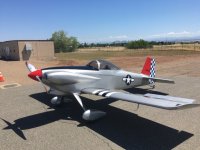side cheeks
My RV-3 has full length (1/2 ice cream cone). My buddy has the cut off ones.
My engine ran very cool when I got it. The oil cooler is up front, and I had trouble getting oil temps up above 150. The Vans oil shutter solved that.
As far as cooling, I re-shaped the cowling to more/less what the Sam James cowl is, (2) 4" round inlets connected to an engine plenum. My interpretation is that the inlets are generous on the stock cowl. I run my oil shutter full closed until its over 90 deg OSA, and even then I just crack it to get the oil around the 200 mark.
My CHTS all run in the 330 -350 range even on hot days, all the cooling air is directed out the belly where the exhaust comes out.
The round inlets are cleaner with less frontal area, and the ram air effect keeps temps in control even when its 100 deg. I can get some flashing of the fuel in my injector lines on top of the engine if I shut down and restart before it cools...But running the boost pump solves that and once airborne, it settles back out.
I like the sleek look of the round inlets, and I filleted and faired out the side scoops when I was prepping for paint. My leg fairings are integrated to the cowling so I have only the vertical seam where the cowl meets the firewall, and the horizontal hinge seam down the sides. Super clean.
Best
Dave





